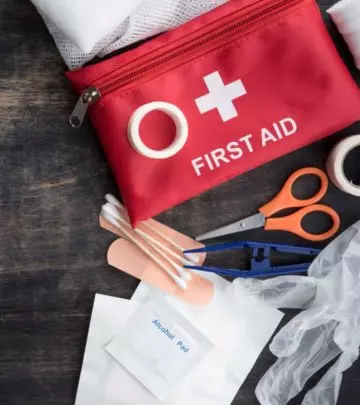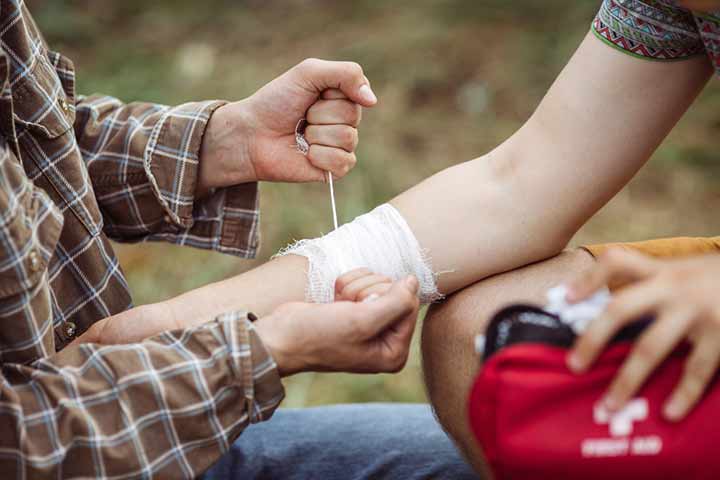
Image: Shutterstock
One of the first things parents teach their kids after they’ve reached a certain age is using a first aid kit. It is even taught in school so that kids know what to do when they fall and get scrapes or cuts. We cannot stop kids from falling when they are growing up. They are prone to bumping into things, brushing up against surfaces that could hurt them, or merely falling while walking or running. If you have a kid, you know what we’re talking about. As a parent, you must have a fully functional first aid kit at your disposal. You could keep it in your car, so you always have access to it and not have to worry about packing it every time you step out. You don’t have to rush your kid to the ER every time they get a small bump or cut in a park or playground. So in light of World First Aid Day, we at MomJunction put together a list of essential items that you would need to provide your child with the immediate care they need in case of an emergency:
- Pre-made first aid kit – It has all the essential items you need to cater to a cut or a scrape in the right size. Going out and buying gauze, ointment, cotton, tape, and antibiotic cream to fit into a compact box might be difficult. Therefore, a pre-made kit is perfect for you. Try to find a large box with a sturdy lid so you can add more items to your first aid kit.
Image: Shutterstock
- Water bottle – The first thing you need to do when your kid gets hurt is to clean it with water. It might not be easy to find a clean water source nearby at the time. You could also use the water to tackle dehydration.
- Epi-pen – Ask your doctor for an epi-pen if your family suffers from a history of allergic reactions. Ensure you store it in a place where you have quick access to.
- Sunblock – You might already be following the practice of putting on sunscreen for your kids every time they step out into the sun. But keeping an emergency sunblock cream in your kit is not the worst idea.
- Numbing spray – An over-the-counter wound numbing spray can work wonders for your kid’s sunburn, cuts, or scrapes.
- Baby wipes – Your baby might be old enough to be out of diapers, but a pack of baby wipes is handy to clean their hands and wipe their nose.
Image: Shutterstock
- Chapstick – Chapsticks are lifesavers for when your kid cries about chapped lips for the hundredth time. It can be used to soothe lip injuries, cold sores, and even sunburns.
- Clean towel – A clean towel is ideal for helping you while you clean wounds. It also helps contain bleeding or more serious injuries. A microfiber towel is an excellent addition to your first aid kit.
- Finger splint – If you’re not sure about your finger being intact after a basketball game, a pre-made finger splint can come to your rescue. While you wait to get an x-ray done, wrap your finger with it and help cure it.
- Ace bandages – They are primarily used for sprains or strains, but ace bandages can be used to cover big wounds dressed with cotton. It helps keep your dressing in place when a simple gauze cannot.
Image: Shutterstock
- Small scissors – An essential addition to your first aid kit, a pair of small scissors, is a crucial tool to have in your kit. It makes all the other items in your kit easy to use.
- Medicines – Whether your child is prone to breathing problems like asthma or wheezing or has motion sickness or nausea, keeping a prescription tablet set would help. Ask your doctor and stock up on these essential medicines, so your child will not suffer.
While first aid kits are quite essential to help your child in times of need, do not neglect their need for medical attention by a professional. You can always help ease your child’s immediate pain and discomfort but do not forget that a doctor knows best. Did you find this article helpful? If you did, share it with friends and family so they’re ready when an emergency strikes.
















